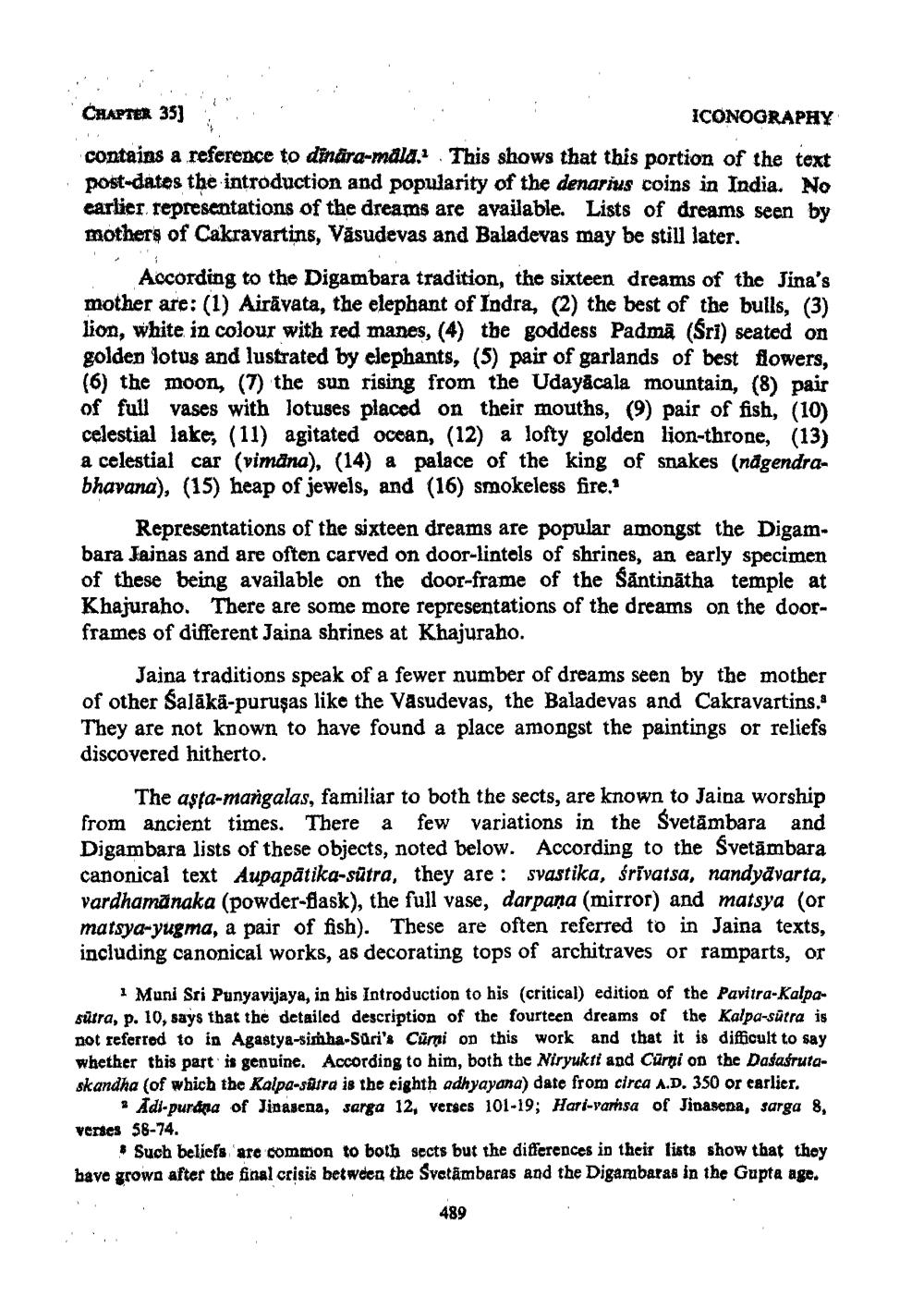________________
CHAPTER 353
ICONOGRAPHY contains a referen.ce to dinara-mala. This shows that this portion of the text post-dates the introduction and popularity of the denarius coins in India. No earlier representations of the dreams are available. Lists of dreams seen by mothers of Cakravartins, Vāsudevas and Baladevas may be still later.
According to the Digambara tradition, the sixteen dreams of the Jina's mother are: (1) Airāvata, the elephant of Indra, (2) the best of the bulls, (3) lion, white in colour with red manes, (4) the goddess Padmā (Sri) seated on golden lotus and lustrated by elephants, (5) pair of garlands of best flowers, (6) the moon, (7) the sun rising from the Udayacala mountain, (8) pair of full vases with lotuses placed on their mouths, (9) pair of fish, (10) celestial lake, (11) agitated ocean, (12) a lofty golden lion-throne, a celestial car (vimana), (14) a palace of the king of snakes (nagendrabhavana), (15) heap of jewels, and (16) smokeless fire,
Representations of the sixteen dreams are popular amongst the Digambara Jainas and are often carved on door-lintels of shrines, an early specimen of these being available on the door-frame of the Santinātha temple at Khajuraho. There are some more representations of the dreams on the doorframes of different Jaina shrines at Khajuraho.
Jaina traditions speak of a fewer number of dreams seen by the mother of other Salākā-purusas like the Vasudevas, the Baladevas and Cakravartins. They are not known to have found a place amongst the paintings or reliefs discovered hitherto.
The asta-mangalas, familiar to both the sects, are known to Jaina worship from ancient times. There a few variations in the Svetämbara and Digambara lists of these objects, noted below. According to the Svetāmbara canonical text Aupapātika-sütra, they are : svastika, srivatsa, nandyavarta, vardhamanaka (powder-flask), the full vase, darpana (mirror) and matsya (or matsya-yugma, a pair of fish). These are often referred to in Jaina texts, including canonical works, as decorating tops of architraves or ramparts, or
1 Muni Sri Punyavijaya, in his Introduction to his (critical) edition of the Pavitra-Kalpasutra, p. 10, says that the detailed description of the fourteen dreams of the Kalpa-sätra is not referred to in Agastya-simha-Sari's Cürni on this work and that it is difficult to say whether this part is genuine. According to him, both the Niryukti and Cūrni on the Dasasrutaskandha (of which the Kalpa-satra is the eighth adhyayana) date from circa A.D. 350 or earlier.
Adi-purana of Jinasena, sarga 12, verses 101-19; Hari-varnsa of Jinasena, sarga 8, Verses 58-74.
* Such beliefs are common to both sects but the differences in their lists show that they have grown after the final crisis between the Svetämbaras and the Digambaras in the Gupta age.
489




